Page 70 of 106

6-26
PERIODIC MAINTENANCE AND MINOR REPAIR
1
2
3
4
56
7
8
9
1
2
a
c
b1.Loosen the locknut at the brake
lever.
2.To increase the brake lever free
play, turn the adjusting bolt in
direction a. To decrease the
brake lever free play, turn the
adjusting bolt in direction b.
3.Tighten the locknut.
EW000101
wIf proper adjustment cannot be
obtained as described, have a
Yamaha dealer make this adjust-
ment.1.Locknut
2.Adjusting bolt
c.Brake lever free play REAR
1
If a brake pad has worn to the point
that the wear indicator groove has
almost disappeared, have a Yamaha
dealer replace the brake pads as a
set.1.Wear indicator groove (´2)REAR
1
1.Wear indicator groove (´2) FRONT
EAU01314
Checking the front and rear
brake padsThe front and rear brake pads must
be checked for wear at the intervals
specified in the periodic maintenance
and lubrication chart. Each brake pad
is provided with a wear indicator
groove, which allows you to check
the brake pad wear without having to
disassemble the brake. To check the
brake pad wear, check the wear indi-
cator grooves.
5GM-9-E1(No ABS) 9/27/00 2:18 PM Page 69
Page 71 of 106
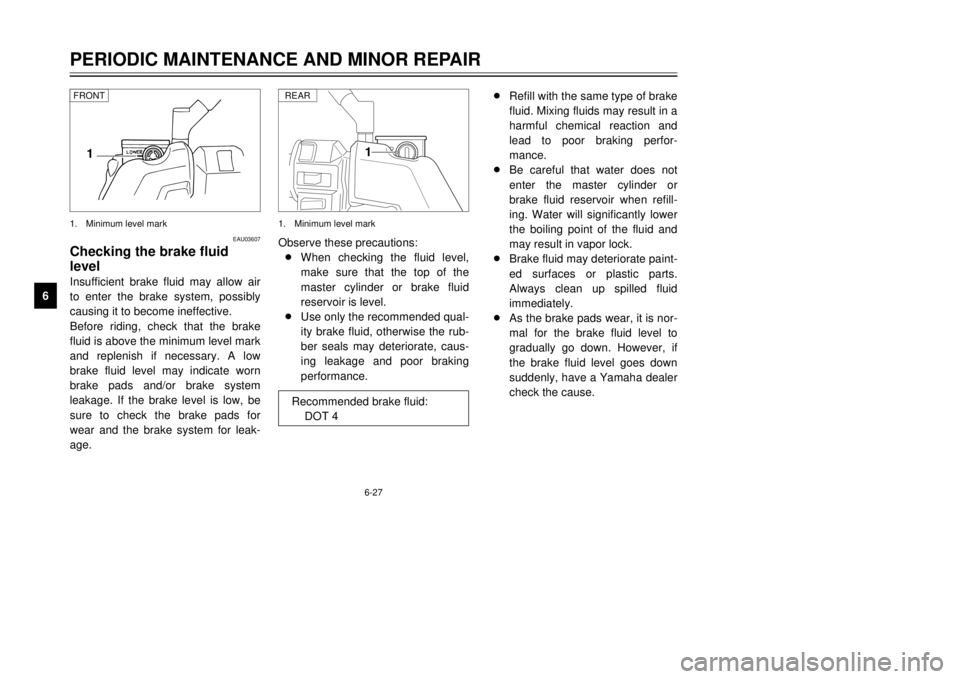
6-27
PERIODIC MAINTENANCE AND MINOR REPAIR
1
2
3
4
56
7
8
9
1
Observe these precautions:
8When checking the fluid level,
make sure that the top of the
master cylinder or brake fluid
reservoir is level.
8Use only the recommended qual-
ity brake fluid, otherwise the rub-
ber seals may deteriorate, caus-
ing leakage and poor braking
performance.1.Minimum level markREARRecommended brake fluid:
DOT 4
8Refill with the same type of brake
fluid. Mixing fluids may result in a
harmful chemical reaction and
lead to poor braking perfor-
mance.
8Be careful that water does not
enter the master cylinder or
brake fluid reservoir when refill-
ing. Water will significantly lower
the boiling point of the fluid and
may result in vapor lock.
8Brake fluid may deteriorate paint-
ed surfaces or plastic parts.
Always clean up spilled fluid
immediately.
8As the brake pads wear, it is nor-
mal for the brake fluid level to
gradually go down. However, if
the brake fluid level goes down
suddenly, have a Yamaha dealer
check the cause.
1
EAU03607
Checking the brake fluid
levelInsufficient brake fluid may allow air
to enter the brake system, possibly
causing it to become ineffective.
Before riding, check that the brake
fluid is above the minimum level mark
and replenish if necessary. A low
brake fluid level may indicate worn
brake pads and/or brake system
leakage. If the brake level is low, be
sure to check the brake pads for
wear and the brake system for leak-
age.1.Minimum level mark FRONT
5GM-9-E1(No ABS) 9/27/00 2:18 PM Page 70
Page 72 of 106
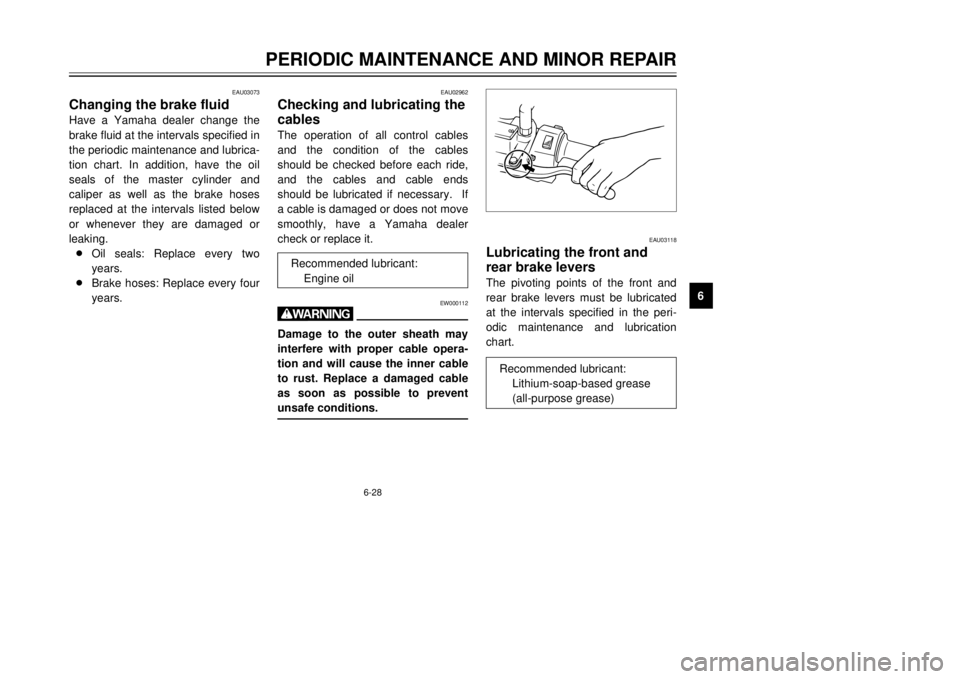
6-28
PERIODIC MAINTENANCE AND MINOR REPAIR
1
2
3
4
56
7
8
9
EAU03073
Changing the brake fluidHave a Yamaha dealer change the
brake fluid at the intervals specified in
the periodic maintenance and lubrica-
tion chart. In addition, have the oil
seals of the master cylinder and
caliper as well as the brake hoses
replaced at the intervals listed below
or whenever they are damaged or
leaking.
8Oil seals: Replace every two
years.
8Brake hoses: Replace every four
years.
EAU02962
Checking and lubricating the
cablesThe operation of all control cables
and the condition of the cables
should be checked before each ride,
and the cables and cable ends
should be lubricated if necessary. If
a cable is damaged or does not move
smoothly, have a Yamaha dealer
check or replace it.
EW000112
wDamage to the outer sheath may
interfere with proper cable opera-
tion and will cause the inner cable
to rust. Replace a damaged cable
as soon as possible to prevent
unsafe conditions.
Recommended lubricant:
Engine oil
EAU03118
Lubricating the front and
rear brake leversThe pivoting points of the front and
rear brake levers must be lubricated
at the intervals specified in the peri-
odic maintenance and lubrication
chart.
Recommended lubricant:
Lithium-soap-based grease
(all-purpose grease)
5GM-9-E1(No ABS) 9/27/00 2:18 PM Page 71
Page 74 of 106
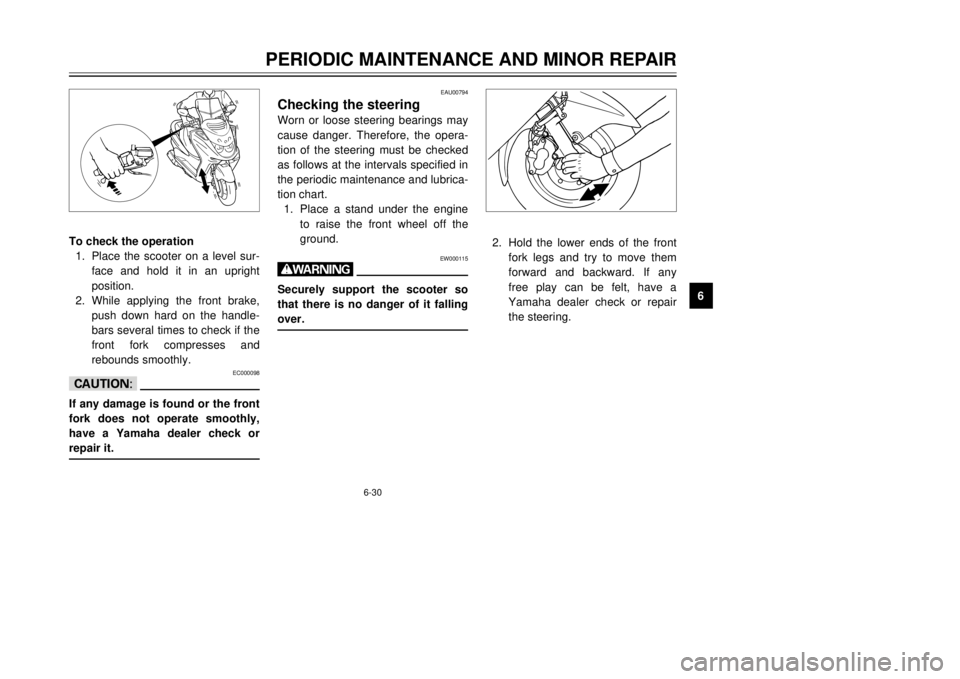
6-30
PERIODIC MAINTENANCE AND MINOR REPAIR
1
2
3
4
56
7
8
9 To check the operation
1.Place the scooter on a level sur-
face and hold it in an upright
position.
2.While applying the front brake,
push down hard on the handle-
bars several times to check if the
front fork compresses and
rebounds smoothly.
EC000098
cCIf any damage is found or the front
fork does not operate smoothly,
have a Yamaha dealer check or
repair it.
EAU00794
Checking the steeringWorn or loose steering bearings may
cause danger. Therefore, the opera-
tion of the steering must be checked
as follows at the intervals specified in
the periodic maintenance and lubrica-
tion chart.
1.Place a stand under the engine
to raise the front wheel off the
ground.
EW000115
wSecurely support the scooter so
that there is no danger of it falling
over.
2.Hold the lower ends of the front
fork legs and try to move them
forward and backward. If any
free play can be felt, have a
Yamaha dealer check or repair
the steering.
5GM-9-E1(No ABS) 9/27/00 2:18 PM Page 73
Page 81 of 106
6-37
PERIODIC MAINTENANCE AND MINOR REPAIR
1
2
3
4
56
7
8
9
EAU03619
Replacing a tail/brake light
bulb1.Place the scooter on the center-
stand.
2.Remove cowling C. (See page
6-10 for cowling removal and
installation procedures.)
EAU03621
Replacing the license plate
light bulb1.Place the scooter on the center-
stand.
2.Remove cowling C. (See page
6-10 for cowling removal and
installation procedures.)
1
1.Socket3.Remove the socket (together
with the bulb) by turning it coun-
terclockwise.
4.Remove the defective bulb by
pushing it in and turning it coun-
terclockwise.
5.Insert a new bulb into the socket,
push it in, and then turn it clock-
wise until it stops.
6.Install the socket (together with
the bulb) by turning it clockwise.
7.Install the cowling.
5GM-9-E1(No ABS) 9/27/00 2:18 PM Page 80
Page 88 of 106
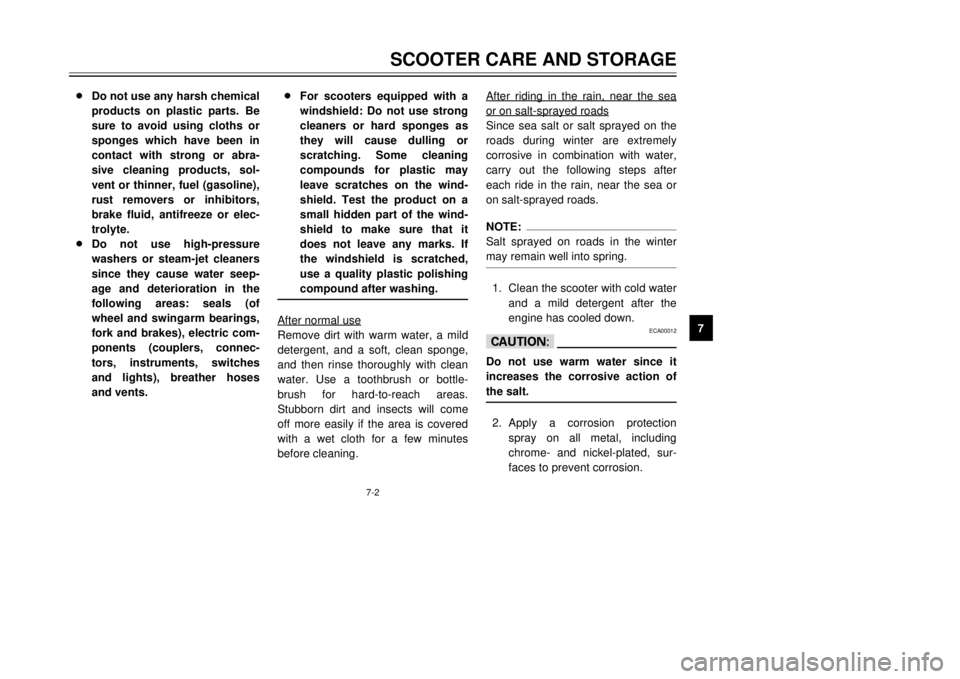
7-2
SCOOTER CARE AND STORAGE
1
2
3
4
5
67
8
9 8Do not use any harsh chemical
products on plastic parts. Be
sure to avoid using cloths or
sponges which have been in
contact with strong or abra-
sive cleaning products, sol-
vent or thinner, fuel (gasoline),
rust removers or inhibitors,
brake fluid, antifreeze or elec-
trolyte.
8Do not use high-pressure
washers or steam-jet cleaners
since they cause water seep-
age and deterioration in the
following areas: seals (of
wheel and swingarm bearings,
fork and brakes), electric com-
ponents (couplers, connec-
tors, instruments, switches
and lights), breather hoses
and vents.8For scooters equipped with a
windshield: Do not use strong
cleaners or hard sponges as
they will cause dulling or
scratching. Some cleaning
compounds for plastic may
leave scratches on the wind-
shield. Test the product on a
small hidden part of the wind-
shield to make sure that it
does not leave any marks. If
the windshield is scratched,
use a quality plastic polishing
compound after washing.
After normal useRemove dirt with warm water, a mild
detergent, and a soft, clean sponge,
and then rinse thoroughly with clean
water. Use a toothbrush or bottle-
brush for hard-to-reach areas.
Stubborn dirt and insects will come
off more easily if the area is covered
with a wet cloth for a few minutes
before cleaning.After riding in the rain, near the sea
or on salt-sprayed roadsSince sea salt or salt sprayed on the
roads during winter are extremely
corrosive in combination with water,
carry out the following steps after
each ride in the rain, near the sea or
on salt-sprayed roads.NOTE:
Salt sprayed on roads in the winter
may remain well into spring.1.Clean the scooter with cold water
and a mild detergent after the
engine has cooled down.
ECA00012
cCDo not use warm water since it
increases the corrosive action of
the salt.2.Apply a corrosion protection
spray on all metal, including
chrome- and nickel-plated, sur-
faces to prevent corrosion.
5GM-9-E1(No ABS) 9/27/00 2:18 PM Page 87
Page 89 of 106
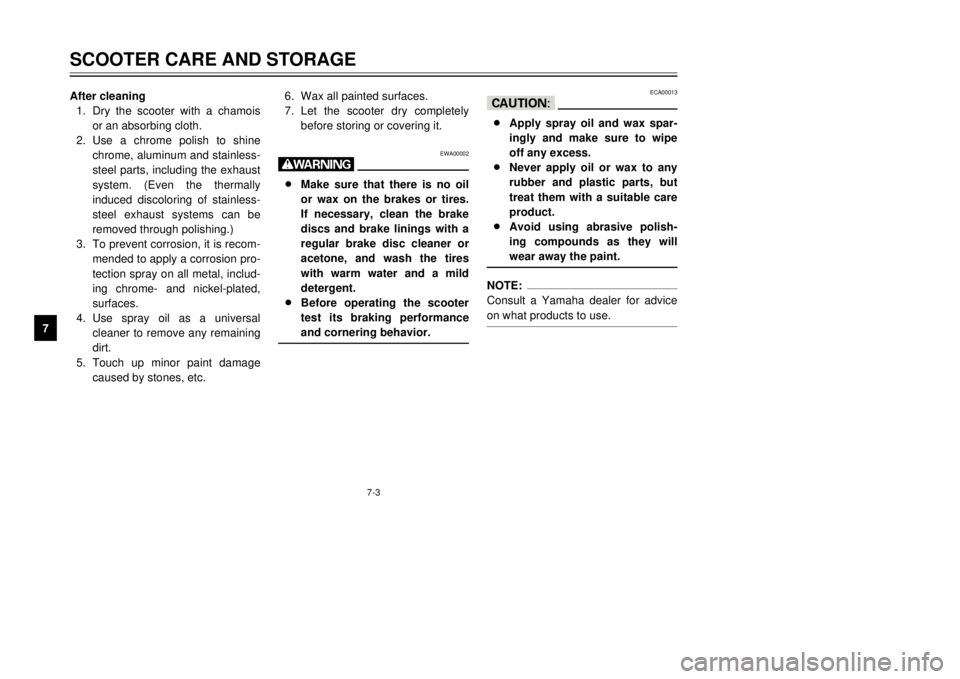
7-3
SCOOTER CARE AND STORAGE
1
2
3
4
5
67
8
9After cleaning
1.Dry the scooter with a chamois
or an absorbing cloth.
2.Use a chrome polish to shine
chrome, aluminum and stainless-
steel parts, including the exhaust
system. (Even the thermally
induced discoloring of stainless-
steel exhaust systems can be
removed through polishing.)
3.To prevent corrosion, it is recom-
mended to apply a corrosion pro-
tection spray on all metal, includ-
ing chrome- and nickel-plated,
surfaces.
4.Use spray oil as a universal
cleaner to remove any remaining
dirt.
5.Touch up minor paint damage
caused by stones, etc.6.Wax all painted surfaces.
7.Let the scooter dry completely
before storing or covering it.
EWA00002
w8Make sure that there is no oil
or wax on the brakes or tires.
If necessary, clean the brake
discs and brake linings with a
regular brake disc cleaner or
acetone, and wash the tires
with warm water and a mild
detergent.
8Before operating the scooter
test its braking performance
and cornering behavior.
ECA00013
cC8Apply spray oil and wax spar-
ingly and make sure to wipe
off any excess.
8Never apply oil or wax to any
rubber and plastic parts, but
treat them with a suitable care
product.
8Avoid using abrasive polish-
ing compounds as they will
wear away the paint.NOTE:
Consult a Yamaha dealer for advice
on what products to use.
5GM-9-E1(No ABS) 9/27/00 2:18 PM Page 88
Page 95 of 106
Wheels
Front
TypeCast wheel
Size12 ´MT2.75
Rear
TypeCast wheel
Size12 ´MT3.50
Brakes
Front
TypeSingle disc brake
OperationRight hand
FluidDOT 4
Rear
TypeSingle disc brake
OperationLeft hand
FluidDOT 4
Suspension
FrontTelescopic fork
RearUnit swingSpring/shock absorbers
FrontCoil spring/oil damper
RearCoil spring/oil damper
Wheel travel
Front100 mm
Rear90 mm
Electrical
Ignition systemTransistorized coil ignition
(digital)
Charging system
TypeA.C. magneto
Standard output14 V, 19.5 A @ 5,000 r/min
Battery
TypeGT7B-4
Voltage, capacity12 V, 6.5 AH
Headlight bulb typeHalogen bulb
Bulb voltage, wattage ´quantity
Headlight12 V, 60/55 W ´1
12 V, 55 W ´1
Tail/brake light12 V, 5/21 W ´2
Front turn signal light12 V, 21 W ´2
Rear turn signal light12 V, 16 W ´2
SPECIFICATIONS
1
2
3
4
5
6
78
9
8-3
5GM-9-E1(No ABS) 9/27/00 2:18 PM Page 94